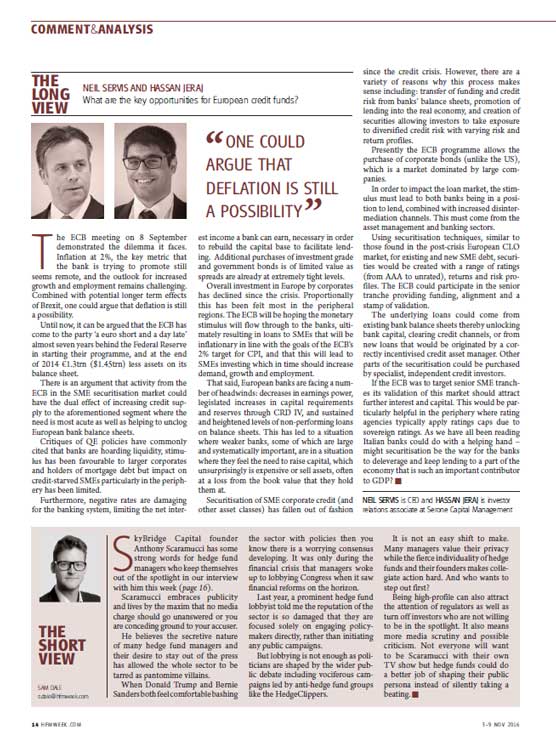HFMWeek. What are the Key Opportunities for European Credit Funds?
“One could argue that defation is still a possibility”

The ECB meeting on 8 September demonstrated the dilemma it faces. Inflation at 2%, the key metric that the bank is trying to promote still seems remote, and the outlook for increased growth and employment remains challenging. Combined with potential longer term effects of Brexit, one could argue that deflation is still a possibility.
Until now, it can be argued that the ECB has come to the party ‘a euro short and a day late’ almost seven years behind the Federal Reserve in starting their programme, and at the end of 2014 €1.3trn ($1.45trn) less assets on its balance sheet.
There is an argument that activity from the ECB in the SME securitisation market could have the dual effect of increasing credit supply to the aforementioned segment where the need is most acute as well as helping to unclog European bank balance sheets.
Critiques of QE policies have commonly cited that banks are hoarding liquidity, stimulus has been favourable to larger corporates and holders of mortgage debt but impact on credit-starved SMEs particularly in the periphery has been limited.
Furthermore, negative rates are damaging for the banking system, limiting the net interest income a bank can earn, necessary in order to rebuild the capital base to facilitate lending. Additional purchases of investment grade and government bonds is of limited value as spreads are already at extremely tight levels.
Overall investment in Europe by corporates has declined since the crisis. Proportionally this has been felt most in the peripheral regions. The ECB will be hoping the monetary stimulus will flow through to the banks, ultimately resulting in loans to SMEs that will be inflationary in line with the goals of the ECB’s 2% target for CPI, and that this will lead to SMEs investing which in time should increase
demand, growth and employment.
That said, European banks are facing a number of headwinds: decreases in earnings power, legislated increases in capital requirements and reserves through CRD IV, and sustained and heightened levels of non-performing loans on balance sheets. This has led to a situation where weaker banks, some of which are large and systematically important, are in a situation where they feel the need to raise capital, which unsurprisingly is expensive or sell assets, often at a loss from the book value that they hold them at.
Securitisation of SME corporate credit (and other asset classes) has fallen out of fashion since the credit crisis. However, there are a
variety of reasons why this process makes sense including: transfer of funding and credit risk from banks’ balance sheets, promotion of
lending into the real economy, and creation of securities allowing investors to take exposure to diversified credit risk with varying risk and return profiles.
Presently the ECB programme allows the purchase of corporate bonds (unlike the US), which is a market dominated by large companies. In order to impact the loan market, the stimulus must lead to both banks being in a position to lend, combined with increased disintermediation channels. This must come from the asset management and banking sectors.
Using securitisation techniques, similar to those found in the post-crisis European CLO market, for existing and new SME debt, securities would be created with a range of ratings (from AAA to unrated), returns and risk profiles. The ECB could participate in the senior tranche providing funding, alignment and a stamp of validation.
The underlying loans could come from existing bank balance sheets thereby unlocking bank capital, clearing credit channels, or from new loans that would be originated by a correctly incentivised credit asset manager. Other parts of the securitisation could be purchased by specialist, independent credit investors.
If the ECB was to target senior SME tranches its validation of this market should attract further interest and capital. This would be particularly helpful in the periphery where rating agencies typically apply ratings caps due to sovereign ratings. As we have all been reading Italian banks could do with a helping hand – might securitisation be the way for the banks to deleverage and keep lending to a part of the economy that is such an important contributor to GDP?
Published
11 November 2016


